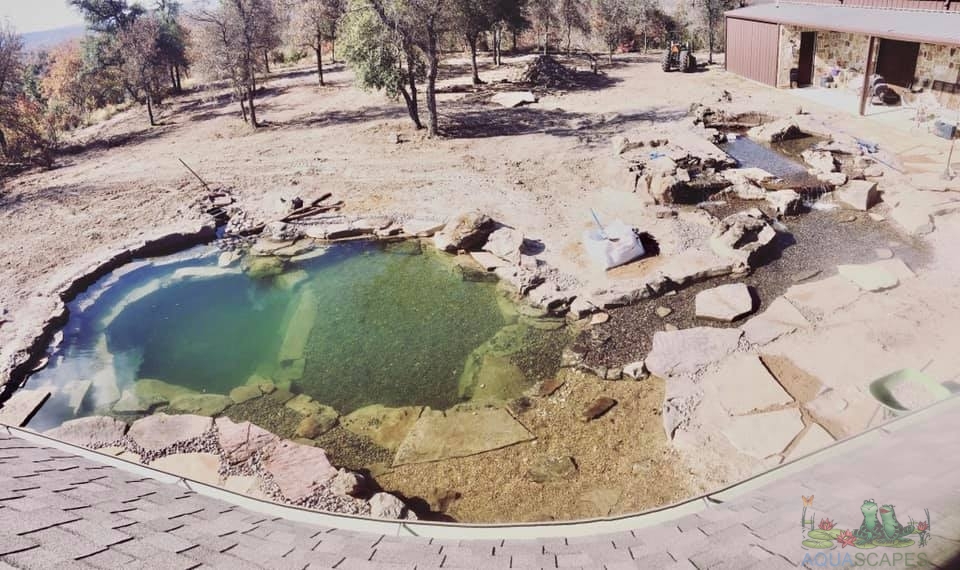[av_textblock fold_type=” fold_height=” fold_more=’Read more’ fold_less=’Read less’ fold_text_style=” fold_btn_align=” textblock_styling_align=” textblock_styling=” textblock_styling_gap=” textblock_styling_mobile=” size=” av-desktop-font-size=” av-medium-font-size=” av-small-font-size=” av-mini-font-size=” font_color=” color=” fold_overlay_color=” fold_text_color=” fold_btn_color=’theme-color’ fold_btn_bg_color=” fold_btn_font_color=” size-btn-text=” av-desktop-font-size-btn-text=” av-medium-font-size-btn-text=” av-small-font-size-btn-text=” av-mini-font-size-btn-text=” fold_timer=” z_index_fold=” id=” custom_class=” template_class=” av_uid=’av-l6qomp92′ sc_version=’1.0′ admin_preview_bg=”]
How to Winterize Your Pond: A Step-by-Step Guide
Preparing your pond for winter is crucial to ensure the health of your aquatic life and the longevity of your pond features. Proper winterization protects fish, plants, and equipment from freezing temperatures and harsh weather conditions. Here’s a step-by-step guide on how to winterize your pond effectively.
1. Remove Debris
Why: Leaves, twigs, and other organic matter can decay under the ice, leading to poor water quality.
How:
- Use a pond net or skimmer to remove leaves and debris from the pond surface and bottom.
- Clean out any accumulated waste from around the edges.
2. Check Water Levels
Why: Low water levels can lead to freezing and damage to pond equipment.
How:
- Ensure your pond is filled to its proper level before winter.
- Add water if necessary, making sure to use a dechlorinator if using tap water.
3. Test Water Quality
Why: Ensuring good water quality helps maintain a stable environment for fish and beneficial bacteria.
How:
- Test for pH, ammonia, nitrite, and nitrate levels using a pond water testing kit.
- Make any necessary adjustments to maintain optimal water quality.
4. Prepare Your Fish
Why: Fish need special care to survive the winter months.
How:
- Gradually reduce feeding as water temperatures drop below 50°F (10°C). Fish become less active and require less food.
- Monitor fish for any signs of illness or stress, and treat as necessary.
5. Install a Pond Heater or Aerator
Why: Preventing the pond from freezing completely is essential for gas exchange.
How:
- Use a pond heater or floating de-icer to keep a section of the pond surface clear of ice.
- Alternatively, install an aerator to keep the water circulating and prevent ice formation.
6. Protect Your Pond Equipment
Why: Pumps, filters, and other equipment can be damaged by freezing temperatures.
How:
- Remove pumps and filters from the pond and clean them thoroughly before storing.
- Store equipment in a dry, frost-free location until spring.
7. Trim Back Plants
Why: Overgrown plants can become tangled and damaged during winter.
How:
- Trim back any aquatic plants, but leave some stems above the water surface for fish shelter.
- Remove any dead or decaying plant matter to prevent it from affecting water quality.
8. Winterize Water Features
Why: Fountains, waterfalls, and other features can be damaged by freezing.
How:
- Drain and clean any pumps, and store them properly.
- If your fountain or waterfall cannot be drained, consider using a de-icer to keep the water flowing.
9. Insulate the Pond
Why: Insulation can help maintain a stable water temperature during extreme cold.
How:
- If your pond is shallow, consider adding a layer of mulch or leaves around the edges to provide insulation.
- Use floating insulation devices if you have a larger pond.
10. Monitor Throughout the Winter
Why: Regular checks can help catch any issues before they become serious.
How:
- Periodically check the pond to ensure that the heater is functioning and that there’s no ice formation over the entire pond.
- Watch for any signs of fish distress or water quality issues.
Wrapping Up Pond Winterization
Winterizing your pond is essential for protecting your aquatic life and maintaining a healthy ecosystem. By following these steps, you can ensure that your pond remains in good condition throughout the winter months. When spring arrives, your pond will be ready to thrive once again, providing beauty and tranquility in your outdoor space. Happy pond keeping!
[/av_textblock]
[av_image src=’https://aquascapes.com/wp-content/uploads/2021/07/Rec-Pond-12.jpg’ attachment=’10951′ attachment_size=’full’ src_dynamic=” copyright=” caption=” image_size=” styling=” box_shadow=’none’ box_shadow_width=’10’ box_shadow_color=” align=’center’ font_size=” overlay_opacity=’0.4′ overlay_color=’#000000′ overlay_text_color=’#ffffff’ link=” link_dynamic=” target=” animation=’no-animation’ animation_duration=” animation_custom_bg_color=” animation_z_index_curtain=’100′ parallax_parallax=” parallax_parallax_speed=” av-desktop-parallax_parallax=” av-desktop-parallax_parallax_speed=” av-medium-parallax_parallax=” av-medium-parallax_parallax_speed=” av-small-parallax_parallax=” av-small-parallax_parallax_speed=” av-mini-parallax_parallax=” av-mini-parallax_parallax_speed=” hover=” blur_image=” grayscale_image=” fade_image=” appearance=” css_position=” css_position_location=’,,,’ css_position_z_index=” av-desktop-css_position=” av-desktop-css_position_location=’,,,’ av-desktop-css_position_z_index=” av-medium-css_position=” av-medium-css_position_location=’,,,’ av-medium-css_position_z_index=” av-small-css_position=” av-small-css_position_location=’,,,’ av-small-css_position_z_index=” av-mini-css_position=” av-mini-css_position_location=’,,,’ av-mini-css_position_z_index=” transform_perspective=” transform_rotation=’,,,’ transform_scale=’,,’ transform_skew=’,’ transform_translate=’,,’ av-desktop-transform_perspective=” av-desktop-transform_rotation=’,,,’ av-desktop-transform_scale=’,,’ av-desktop-transform_skew=’,’ av-desktop-transform_translate=’,,’ av-medium-transform_perspective=” av-medium-transform_rotation=’,,,’ av-medium-transform_scale=’,,’ av-medium-transform_skew=’,’ av-medium-transform_translate=’,,’ av-small-transform_perspective=” av-small-transform_rotation=’,,,’ av-small-transform_scale=’,,’ av-small-transform_skew=’,’ av-small-transform_translate=’,,’ av-mini-transform_perspective=” av-mini-transform_rotation=’,,,’ av-mini-transform_scale=’,,’ av-mini-transform_skew=’,’ av-mini-transform_translate=’,,’ mask_overlay=” mask_overlay_shape=’blob’ mask_overlay_size=’contain’ mask_overlay_scale=’100%’ mask_overlay_position=’center center’ mask_overlay_repeat=’no-repeat’ mask_overlay_rotate=” mask_overlay_rad_shape=’circle’ mask_overlay_rad_position=’center center’ mask_overlay_opacity1=’0′ mask_overlay_opacity2=’1′ mask_overlay_opacity3=” title_attr=” alt_attr=” img_scrset=” lazy_loading=’disabled’ id=” custom_class=” template_class=” av_element_hidden_in_editor=’0′ av_uid=’av-m257i4si’ sc_version=’1.0′ admin_preview_bg=”][/av_image]
[av_one_full first min_height=” vertical_alignment=” space=” custom_margin=” margin=’0px’ link=” linktarget=” link_hover=” padding=’0px’ border=” border_color=” radius=’0px’ background=’bg_color’ background_color=” background_gradient_color1=” background_gradient_color2=” background_gradient_direction=’vertical’ src=” background_position=’top left’ background_repeat=’no-repeat’ animation=” mobile_breaking=” mobile_display=” av_uid=’av-10y8z8n’]
[av_textblock size=” font_color=” color=” av-medium-font-size=” av-small-font-size=” av-mini-font-size=” av_uid=’av-108iu6v’ custom_class=” admin_preview_bg=”]
Check out our store for all your water gardening needs! Aquascape products are Aquascape Inc. Certified.
Thanks for reading at Meyer Aquascapes! We hope you’ve enjoyed our post on garden pond design. Please leave a comment below if you liked it or have any questions. We’d love to hear from you! Thanks for stopping by!
[/av_textblock]
[/av_one_full]
[av_hr class=’short’ height=’50’ shadow=’no-shadow’ position=’center’ custom_border=’av-border-thin’ custom_width=’50px’ custom_border_color=” custom_margin_top=’30px’ custom_margin_bottom=’30px’ icon_select=’yes’ custom_icon_color=” icon=’ue808′ font=’entypo-fontello’ av_uid=’av-4bnqpz’ admin_preview_bg=”]
[av_heading heading=’How can we help?’ tag=’h1′ link_apply=” link=” link_target=” style=’blockquote modern-quote modern-centered’ size=” subheading_active=” subheading_size=’15’ margin=” padding=’10’ color=” custom_font=” custom_class=” admin_preview_bg=” av-desktop-hide=” av-medium-hide=” av-small-hide=” av-mini-hide=” av-medium-font-size-title=” av-small-font-size-title=” av-mini-font-size-title=” av-medium-font-size=” av-small-font-size=” av-mini-font-size=”][/av_heading]
[av_textblock size=” font_color=” color=” av-desktop-hide=” av-medium-hide=” av-small-hide=” av-mini-hide=” av-medium-font-size=” av-small-font-size=” av-mini-font-size=” av_uid=’av-334avi’]
[/av_textblock]

